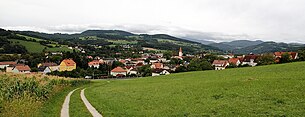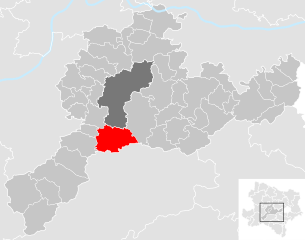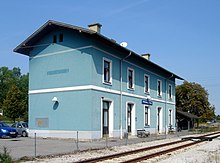Wilhelmsburg (Lower Austria)
|
Borough Wilhelmsburg
|
||
|---|---|---|
| coat of arms | Austria map | |
|
|
||
| Basic data | ||
| Country: | Austria | |
| State : | Lower Austria | |
| Political District : | Sankt Pölten-Land | |
| License plate : | PL | |
| Surface: | 45.96 km² | |
| Coordinates : | 48 ° 7 ' N , 15 ° 37' E | |
| Height : | 321 m above sea level A. | |
| Residents : | 6,492 (January 1, 2020) | |
| Population density : | 141 inhabitants per km² | |
| Postal code : | 3150 | |
| Area code : | 0 27 46 | |
| Community code : | 3 19 47 | |
| NUTS region | AT123 | |
| Address of the municipal administration: |
Hauptplatz 13 3150 Wilhelmsburg |
|
| Website: | ||
| politics | ||
| Mayor : | Rudolf Ameisbichler ( SPÖ ) | |
|
Municipal Council : ( 2020 ) (29 members) |
||
| Location of Wilhelmsburg in the Sankt Pölten-Land district | ||
 North view of Wilhelmsburg |
||
| Source: Municipal data from Statistics Austria | ||
Wilhelmsburg is a Lower Austrian town in the Mostviertel in the St. Pölten-Land district in Austria with 6,492 inhabitants (as of January 1, 2020).
The Traisen flows through the municipality .
geography
Wilhelmsburg is located about twelve kilometers south of the city center of St. Pölten. The Traisen flows through the municipality from south to north . The eastern urban area belongs to the foothills of the Vienna Woods , the western urban area to the foothills of the Türnitz Alps . Both mountain groups are separated by the Traisen.
The highest elevations in the urban area are the Stockerhöhe at 734 m above sea level. A. in the south and the Haberegg at 693 m above sea level. A. in the southeast, the lowest point is at approx. 310 m above sea level. A. where in the district of Reith the Traisen leaves the municipality to the north.
Community structure
The municipality of Wilhelmsburg is the only locality to include Wilhelmsburg and consists of the cadastral communities Altenburg, Göblasbruck, Handelberg, Kanzling, Kreisbach, Pömmern, Wegbach, Wielandsberg, Wilhelmsburg and Wolkersberg. The districts are distributed as follows:
- KG Altenburg: no further districts
- KG Göblasbruck: Bösendörfl, Grubtal Hochstraß, Kendlgraben and Sonnenberg as well as several individual layers
- KG Handelberg: no further districts
- KG Kanzling: no further districts
- KG Kreisbach: Reith and several individual layers
- KG Pommern: a single location
- KG Wegbach: no further districts
- KG Wielandsberg: no further districts
- KG Wilhelmsburg: a single location
- KG Wolkersberg: a single location
Neighboring communities
Wilhelmsburg borders the district and state capital St. Pölten in the north . To the east is the municipality of Pyhra , which is separated by the watershed between Traisen and Perschling . The neighboring community in the southeast is Sankt Veit an der Gölsen , while Wilhelmsburg borders Eschenau in the southwest . Both communities do not belong to the Sankt Pölten-Land district , but to the adjacent Lilienfeld district . In the west, the city borders on Hofstetten-Grünau and in the northwest on Weinburg .
history
Settlement before 850 , when a Frankish nobleman named Wilhelm founded a castle here during the time of the Baierischen Ostland , cannot be proven by finds, but is likely. The first church was built in the 10th century, and the city was first mentioned in 1083 under the name Willehalmspurch . In 1180 Dietricus I. de K´Chrebezbach built the Kreisbach Castle .
The Babenberg Duke Leopold VI. In 1209 he gave Lilienfeld Abbey all its goods, rights and freedoms in and around Wilhelmsburg, and the parish is also mentioned for the first time this year. Wilhelmsburg has had market rights since 1279.
The Marienkapelle in Kirchengasse was inaugurated in 1320, and in 1330 the construction of the curtain wall around the church and place began.
A major fire destroyed the town center in 1457, after which the construction of the parish church began. During the 1st Turkish siege in 1529, the market was protected by the curtain wall, which was raised from 1568 to 1587.
In 1580 the abbot Georg Premberger founded a poor citizens' hospital in today's Untere Hauptstrasse 20. Towards the end of the Peasant Wars in 1597, the peasant army north of Wilhelmsburg was crushed by the imperial armed forces. Because of this, the curtain wall was reinforced again from 1607 to 1627.
During the second Turkish siege in 1683, Wilhelmsburg was almost spared. In 1805 and 1809 Wilhelmsburg was sacked by Napoleon's troops.
Industrialization began in 1830 with the opening of a cotton mill in Göblasbruck.
The demolition of the fortifications began between 1835 and 1837 and the first post office was built the following year . The railway station opened in 1877, and the Leobersdorf - St. Pölten railway was used continuously.
On March 13, 1900, the new cemetery was inaugurated at its current location, and in 1901 the planning of the siding between the train station and the crockery factory took place.
In the years after 1899 the Traisen was regulated and the second Viennese spring water pipeline was built, which created numerous jobs. The expansion of industry in the area also led to an increased demand for workers.
On March 29, 1920, 34 houses and 10 outbuildings were cremated in a major fire, and the old town hall also fell victim to the flames.
In 1926 a railway stop was opened in Göblasbruck, and in 1927 the first bus connection with St. Pölten had its maiden voyage .
Wilhelmsburg, Göblasbruck and Kreisbach united in 1938 to form a large community.
The Arbeiter-Samariterbund (ASBÖ) was founded in 1950 and in 1956 the construction of a bypass road began, with the route being opened to traffic gradually until 1958.
The city charter was Wilhelmsburg 1959th
On December 2, 1999, the gas explosion in Conrad-Lester-Hof 4 claimed ten lives; a 15-year-old girl was rescued from the heap of rubble. A memorial was erected at the site of the accident, and the damaged neighboring building could be used again in 2001.
population
Population development

In the first census in 1869 , Wilhelmsburg had 1,432 residents, while Göblasbruck and Kreisbach had 1809.
Around 91% of the population of Wilhelmsburg are Austrian citizens, around 4% citizens of Bosnia-Herzegovina , around 2% citizens of Turkey and around 2% citizens of Serbia and Montenegro . Around 90% of the citizens cite German as their colloquial language, around 4% Serbian , around 2% Turkish and around 1% Croatian .
religion
Around 67% of the population profess to the Roman Catholic Church , around 5% to the Protestant Church , around 5% to the Orthodox Church and around 4% to Islam . Around 18% of citizens are non-denominational.
Culture and sights
Wilhelmsburg Crockery Museum
The museum was opened in 2007 and is dedicated to the 'Wilhelmsburg stoneware' and lily porcelain produced in Wilhelmsburg from 1795 to 1997 . It shows u. a. the legendary 'Daisy' lily porcelain series produced in the 1950s. The crockery museum is located in Wilhelmsburg, Färbergasse 11.
Kreisbach Castle
Kreisbach Castle is said to have been founded and built at the end of the 12th century . As early as 1323 Schloss Kreisbach was bought by the Lords of Hohenberg and then to the Lords of Roggendorf . In 1521, Wolfgang Jörger acquired the Kreisbach castle and estate. The Jörgers turned out to be the most ardent supporters of Lutheranism. The new doctrine quickly gained a foothold in all classes and Catholic pastors also converted. At that time Wilhelmsburg was a bastion of the Lutherans, the spiritual center for all churches in the villages in the Traisen and Gölsental.
As an enthusiastic fighter for Protestantism , the last Jörger named Helmhard was declared forfeited and expelled from the country by the Catholic Emperor Ferdinand II in the course of the Counter Reformation.
The ownerless estate of Kreisbach was sold to the Lilienfeld Abbey in 1625, who had the castle chapel torn down and converted part of the Jörger's former ballroom into a new chapel. Today's Anna Chapel shows stucco work on its barrel vault from the earliest Baroque .
Today there is not much to see of the stately, four-tower castle and its defensive wall. Even when Kreisbach was a district office , investments in maintenance were not made, and building materials were even withdrawn from here if necessary.
In 1994 the idea for the renovation and revitalization of Schloss Kreisbach arose, and since October 1999 the Kulturverein Schloss Kreisbach has been trying to implement this idea.
music
- Stadtkapelle Wilhelmsburg: The Stadtkapelle Wilhelmsburg is the oldest active music association in Wilhelmsburg. It was founded on June 21, 1921 under the name Orchesterbund Wilhelmsburg (chairman Johann Klug, conductor Rudolf Kössler). The two longest active functionaries of the Wilhelmsburg town band were honorary bandmaster Professor Willibald Wltschek (bandmaster from 1953 to 1993) and honorary chairman Eduard Zeller (chairman from 1968 to 1987).
politics
The municipal council has 29 seats, the mayor of the municipality is Rudolf Ameisbichler, and Thorsten Sassmann, head of the municipal office.
In the 2005 municipal council elections , the SPÖ received 17, the ÖVP 10 and the Greens 2 seats.
In the municipal council elections in 2010 , the three parties previously represented in the council lost one seat each to the FPÖ, which moved into the council. In the 2015 municipal council elections , two mandates were shifted from the ÖVP to the Greens.
Economy and Infrastructure
In 2001 there were 234 non-agricultural workplaces, agricultural and forestry operations 136 according to the 1999 survey. According to the 2001 census, the number of people in employment in the place of residence was 2921. In 2001 the employment rate was 45.16%.
traffic
Wilhelmsburg is located on Mariazeller Straße B20 and on the Traisentalbahn . In addition to the Wilhelmsburg train station, the Kreisbach and Göblasbruck stops are also located in the municipality.
Wilhelmsburg lies with the Voralpenweg and the Lower Austrian Mariazellerweg on two Austrian long-distance hiking trails and is also the starting and ending point of the Traisentaler Rundwanderweg .
Personalities
Sons and daughters:
- Johann Wilhelm von Mannagetta (1588–1666), personal physician to Ferdinand II, Ferdinand III. and Leopold I, author of a plague ordinance and founder of the "Mannagettasche Foundation"
- Walter Kudlich (1857–1930), member of the Silesian state parliament, mayor of Troppau
- August Schmid-Schmidsfelden (1892–1978), industrialist in the iron and steel industry
- Adolf Treberer-Treberspurg (1911–1955), sculptor between Expressionism and Modernism, worked in Turkey between the wars and later in Vienna
- Fritz Küffer (1911–2001), painter
- Karl Röhrl (1941–2016), chess player
- Monika Langthaler (* 1965), politician and entrepreneur
- Franz Renz (* 1968), chemist
People related to the city:
- Richard Lichtenstern (1870–1937), entrepreneur, took over the Wilhelmsburg stoneware and porcelain factory from his father in 1895
- Othmar Steinbauer (1895–1962), Viennese sound series composer, spent many years in the Altenburg district on summer vacation and died there on September 5, 1962
- Bernhard Paul (* 1947), circus director, grew up in Wilhelmsburg
- Benjamin Karl (* 1985), snowboarder, world champion, silver medalist at the 2010 Olympic Winter Games
Web links
- Stadtgemeinde Wilhelmsburg Homepage of the municipality
- Tourism info
- 31947 - Wilhelmsburg. Community data, Statistics Austria .
- Wilhelmsburg Crockery Museum
Individual evidence
- ↑ a b Wilhelmsburg community data at Statistics Austria (PDF; 10 kB)
- ^ Election result of the municipal council election 2005 in Wilhelmsburg. Office of the Lower Austrian State Government, March 4, 2005, accessed on November 22, 2018 .
- ^ Election result of the municipal council election 2010 in Wilhelmsburg. Office of the Lower Austrian State Government, October 8, 2010, accessed on November 22, 2018 .
- ^ Election results for the 2015 municipal council elections in Wilhelmsburg. Office of the Lower Austrian State Government, December 1, 2015, accessed on November 22, 2018 .








